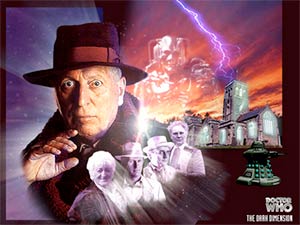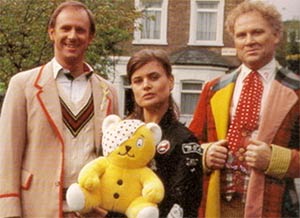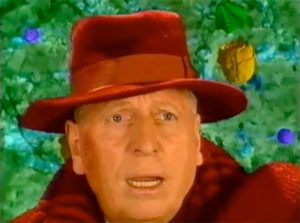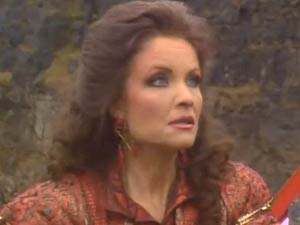Dimensions in Time: A Positive Outlook on 30 Years of Who
Ahead of tonight’s Children in Need, John Hussey looks back on the most notorious special to come from the event.
I’m a firm believer that one must appreciate the things in life they love the most. If you love something from the bottom of your heart, then surely you can find all the good from within that thing and discard the little problems. This is how I feel about Doctor Who. To me every episode is a gem. Whether the episode be utterly brilliant or just downright awful. The point is even in an episode where I can find flaws or distaste, I can always find something good within that episode and its story (and yes I speak about abominations such as ‘Love & Monsters’, ‘The Web Planet’ and ‘Underworld’). In my eyes, one cannot hate a show that you are dedicated to. There’s no point really. It’s all about supporting it and going along for the ride through thick and thin. Just enjoy the magic I say. Today, I’m going to look back at possibly the most controversial episode in Doctor Who’s history and speak about why I think it was a great episode and why others should too.
Looking Back in Time with a Different Perspective

Now some would say that idea was rubbish but what I intend to try and do with this article is at least change your perspective on this underrated gem and make it see new light and appreciation.
The story (for its slight flaws) does prove to be an entertaining 12 minutes of seeing the different Doctors and companions run around, mingling and solving a great mystery that affects them all. The fact of the matter is that John Nathan-Turner was allowed to write an anniversary episode for the show’s 30th Anniversary. Now it might not have been as glamorous and spectacular as some fans might have expected but when one has massive amounts of restraints placed upon them, it’s harder to make something as memorable. One of the major flaws with ‘Dimensions in Time’ was the low amount of budget it received, near to none in fact (with some cases stating the actors worked for free). Also the BBC demanded that the special would contain a cross-over with EastEnders. Now there’s another amount of restraint because now you have to confine yourself into one location and now include characters from two separate franchises that should never come together. Nonetheless, an episode was produced and I think it proved to be very successful.
‘The Dark Dimension’: The Lost 30th Anniversary Plot
 I will now revert you all to the lost plot for the original 30th Anniversary Special which consisted of the Fourth Doctor (played by Tom Baker) to be the dominate role. This idea came about when in 1992 Tom Baker wished to return to the role of the Doctor and so set about with the idea for what was to become ‘The Dark Dimensions’. The story, written by Adrian Rigelsford and directed by Graeme Harper, would’ve told the story of an evil creature who prevented the Fourth Doctor from regenerating in the events of ‘Logopolis’ and thereby creating a ‘dark dimension’. In order to prevent time falling apart and his future incarnations from being erased, the Fourth Doctor would have to battle to revert time to its proper place.
I will now revert you all to the lost plot for the original 30th Anniversary Special which consisted of the Fourth Doctor (played by Tom Baker) to be the dominate role. This idea came about when in 1992 Tom Baker wished to return to the role of the Doctor and so set about with the idea for what was to become ‘The Dark Dimensions’. The story, written by Adrian Rigelsford and directed by Graeme Harper, would’ve told the story of an evil creature who prevented the Fourth Doctor from regenerating in the events of ‘Logopolis’ and thereby creating a ‘dark dimension’. In order to prevent time falling apart and his future incarnations from being erased, the Fourth Doctor would have to battle to revert time to its proper place.
The Fourth Doctor would’ve been joined by Ace and the Brigadier with the Third, Fifth, Sixth and Seventh Doctors appearing in minor roles throughout the story. The story would’ve also featured appearances from major iconic villains such as the Daleks, the Cybermen, the Ice Warriors and the Yeti. It would have also had an appearance from Bernice Summerfield, who appeared as the Seventh Doctor’s companion within the New Adventures book series. This story was unfortunately scrapped. So a better plot than ‘Dimensions in Time’ was originally intended but unfortunately, as the Doctor has pointed out on numerous occasions, time doesn’t always go according to plan.
Celebrating a Legacy with a Happy Reunion
 The key feature within John Nathan-Turner’s tenure on the show was his love of doing things for the fans. Now whether or not this was the best idea in the world due to alienating your more casual viewer, but at least it maintained the show’s continuity and kept it flowing with not only new ideas, but kept the old ones alive and running. ‘The Five Doctors’ proved a massive success in celebrating the show’s 20th Anniversary just as ‘Dimensions in Time’ was a success in celebrating the show’s 30th Anniversary, just not as much as its previous celebration. Yes I will admit ‘Dimensions in Time’ has its flaws, namely through low budget and lack of time to really propel the story into further field (plus the characters within the EastEnders universe don’t exactly bring much to the table) but one has to look at the good that the story already produces and then forget about the ‘what ifs’ and ‘could’ve been’.
The key feature within John Nathan-Turner’s tenure on the show was his love of doing things for the fans. Now whether or not this was the best idea in the world due to alienating your more casual viewer, but at least it maintained the show’s continuity and kept it flowing with not only new ideas, but kept the old ones alive and running. ‘The Five Doctors’ proved a massive success in celebrating the show’s 20th Anniversary just as ‘Dimensions in Time’ was a success in celebrating the show’s 30th Anniversary, just not as much as its previous celebration. Yes I will admit ‘Dimensions in Time’ has its flaws, namely through low budget and lack of time to really propel the story into further field (plus the characters within the EastEnders universe don’t exactly bring much to the table) but one has to look at the good that the story already produces and then forget about the ‘what ifs’ and ‘could’ve been’.
What ‘Dimensions in Time’ has going for it is its inclusion of the many actors and actresses from the shows legacy. The episode brought back all the remaining Doctors (at the time) along with a handful of different companions that travelled alongside them. So for a geeky fan who enjoys the possibilities of different Doctors and companions meeting one another, ‘Dimensions in Time’ ticks the boxes for me.
We had Jon Pertwee reprising his legendary role as the Third Doctor teaming up alongside Melanie Bush (Bonnie Langford), Sarah Jane Smith (Elizabeth Sladen), Liz Shaw (Caroline John), Mike Yates (Richard Franklin), Brigadier Lethbridge-Stewart (Nicholas Courtney) and Victoria Waterfield (Deborah Watling). We then had Peter Davison making a quick comeback as the Fifth Doctor (for the first time since his departure in ‘The Caves of Androzani’) working alongside his companions Nyssa (Sarah Sutton) and Peri Brown (Nicola Bryant). Then we have Colin Baker making a daring return to the show as the Sixth Doctor after his misfortunate mistreatment during his own tenure in the previous decade. Colin Baker’s Sixth Doctor worked alongside Ace (Sophie Aldred), Susan Foreman (Carole Ann Ford) and Brigadier Lethbridge-Stewart.
 We even had a cameo appearance from Tom Baker, who had opted out from appearing in the previous Anniversary Special (which Baker later admitted was a huge mistake on his part), reprising his much loved Fourth Doctor in which depicted him warning his other selves about the Rani’s sinster plans. And of course we had the then current Doctor Sylvester McCoy coming back to play his manipulative Seventh incarnation working alongside Ace, Leela (Louise Jameson) and K9 (John Leeson). There was even the appearance of Lalla Ward appearing as Romana II who spoke the First Question: Doctor Who?
We even had a cameo appearance from Tom Baker, who had opted out from appearing in the previous Anniversary Special (which Baker later admitted was a huge mistake on his part), reprising his much loved Fourth Doctor in which depicted him warning his other selves about the Rani’s sinster plans. And of course we had the then current Doctor Sylvester McCoy coming back to play his manipulative Seventh incarnation working alongside Ace, Leela (Louise Jameson) and K9 (John Leeson). There was even the appearance of Lalla Ward appearing as Romana II who spoke the First Question: Doctor Who?
Just look at the amount of people who were involved within the mini-celebration story and that was just from the side of good. On the evil side we had Kate O’Mara coming back as the twisted Time Lady the Rani who previously fought against the Sixth Doctor in ‘The Mark of the Rani’ and then later against the Seventh Doctor in ‘Time and the Rani’. The Rani also released a horde of enemies left, right and centre upon the Doctor’s. The list included a Argolin, a Biomechanoid, a Cyberman, Fifi, a Mentor, an Ogron, a Sandminer Robot, a Sea Devil, a Tetrap, a Time Lord, a Tractator, a Vanir, a Verviod, Zog and Kiv. The story was certainly cram-packed with plenty of characters from the past in order to celebrate 30 years of the show’s history and legacy.
Why ‘Dimensions in Time’ Worked
 The special worked because it was fun, which is what Doctor Who is all about at the end of the day. Sure the story could’ve been more thought out and even have been longer but there’s no point fretting over what could have and what should have happened. The fact of the matter is it’s already been set in stone and is a part of the show’s mythology whether you accept it or not. By looking at ‘Dimensions in Time’ with a positive outlook, you see its possibilities and potential along with what long-term show-runner John Nathan-Turner was trying to do for the fans.
The special worked because it was fun, which is what Doctor Who is all about at the end of the day. Sure the story could’ve been more thought out and even have been longer but there’s no point fretting over what could have and what should have happened. The fact of the matter is it’s already been set in stone and is a part of the show’s mythology whether you accept it or not. By looking at ‘Dimensions in Time’ with a positive outlook, you see its possibilities and potential along with what long-term show-runner John Nathan-Turner was trying to do for the fans.
As I’ve said before, I love multi-Doctor stories. They’re among my favourites within the show for the sole purpose that they are unique. They bring together all the different segments of the Doctor’s soul and life and bring them together in order to play off along another – ultimately leading to funny and entertaining results. It also really helps to celebrate the show by bringing the entire character of the Doctor together onscreen all at once so we can see his vast history and how he has grown and evolved over the show’s history. Not many shows can do that, which is why this concept is unique to Doctor Who. So there’s one massive reason why ‘Dimensions in Time’ worked, it brought all the surviving Doctor’s back but with a nice little twist. Although sadly they didn’t interact (which is what I love most about multi-Doctor stories) it brought about a concept which had the Doctor flicking between incarnations which was just as interesting to see. It reinforces the idea that all the incarnations of the Doctor are the same man, and we see it quite clearly here as he switches from his past and future selves. They aren’t individual entities but one being.
It also brought back a lot of the different companions that we love and adore back to help the Doctor in his hour of need. This is what the story did brilliantly at; celebrating the show’s legacy by having the different actors and actresses being a part of the plot. They even included reference to the late William Hartnell (the original) and Patrick Troughton (the Cosmic-Hobo) by having their faces appear as CGI models at the beginning and end of the story. Along with that you have nice little segments of different Doctors meeting different companions and see how they interact with one another. The most famous includes the Sixth Doctor meeting his grand-daughter Susan Foreman and then later on his best friend the Brigadier (finally making him the only companion to have met all of the Classic Doctor’s).
 The story was quite serious as well when you think about it. The Rani attempted to control the DNA of every single species across the universe and in order to make sure her plans weren’t averted, the mad Time Lady attempted to trap all of the Doctors inside a time-trap. On top of that is the fact that the First and Second Doctor were already caught within the trap and therefore time was already running out for the rest of the Doctors to escape there impending doom. It just shows how insane the Rani is and yet she retains a sense of sanity within her performance, being more of a gentlemen-type villain who is polite to you as they attempt to commence your demise. With this it meant the Doctor’s timeline was in jeopardy as he spiralled backwards and forwards in his time-stream with his different companions. If the Rani had succeeded, the Doctor and his companions would’ve been trapped for all eternity allowing the Rani, and the rest of the universe’s evil to spread across the stars with no one to stop them. But obviously, as indicated in past multi-Doctor stories, three Doctors are better than one, so imagine when there are five. I suppose the downside to the story is its length and cheap nature but that can hardly be a major fault, especially with the restrictions the production team had at the time (remember of course the series had been cancelled by then and so had very little resources to work with).
The story was quite serious as well when you think about it. The Rani attempted to control the DNA of every single species across the universe and in order to make sure her plans weren’t averted, the mad Time Lady attempted to trap all of the Doctors inside a time-trap. On top of that is the fact that the First and Second Doctor were already caught within the trap and therefore time was already running out for the rest of the Doctors to escape there impending doom. It just shows how insane the Rani is and yet she retains a sense of sanity within her performance, being more of a gentlemen-type villain who is polite to you as they attempt to commence your demise. With this it meant the Doctor’s timeline was in jeopardy as he spiralled backwards and forwards in his time-stream with his different companions. If the Rani had succeeded, the Doctor and his companions would’ve been trapped for all eternity allowing the Rani, and the rest of the universe’s evil to spread across the stars with no one to stop them. But obviously, as indicated in past multi-Doctor stories, three Doctors are better than one, so imagine when there are five. I suppose the downside to the story is its length and cheap nature but that can hardly be a major fault, especially with the restrictions the production team had at the time (remember of course the series had been cancelled by then and so had very little resources to work with).
The other thing is of course the cross-over with EastEnders which brought near to nothing to the plot and the characters had no real role to play. Again, that was what the BBC demanded, so that’s what John Nathan-Turner had to work with. If anything, the backdrop of EastEnders just made the Doctor’s near exile more bleak knowing he would be trapped in such a horrible and boring place (at least that’s how I look at it). One thing I believe you need with a show like Doctor Who is imagination and commitment. Lose any of these factors and you start doubting which is a bad thing.
At the end of the day we received a story to celebrate the 30th Anniversary of the show and all those fine actors and actresses who had brought so much to the show returned in order to make the story a reality. It just goes to show how dedicated they were to Doctor Who and I for one join in on giving them support for the hard work they put in. I’d say the one thing ‘Dimensions in Time’ fails at as an Anniversary story is pushing the show forward for the next stage within its legacy. It didn’t do much for developing the show’s future (as in ‘The Three Doctors’ and ‘The Five Doctors’), but at least it said to the audience that although the show was cancelled, it still lives on and will do as long as it has dedicated fans both in front and beyond the screen and you can’t ask for more than that.
I hope I managed to make you see this story within a new light and now you appreciate a little what it did or tried to bring to the table. At the very least thanks for reading and listening to my interpretation of this controversy to the fandom.








